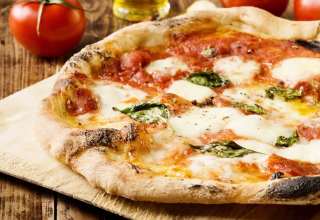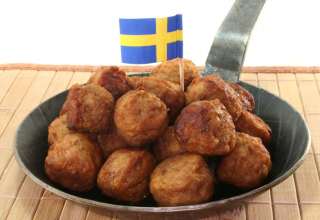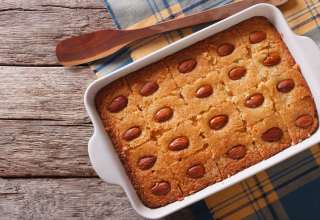The Algarve may be known for mass tourism and packed beaches, but Barnaby Eales finds a simpler – and wilder – corner of the Portuguese coast
I had been lured by a wilder frontier of the Algarve: the east, with its promise of immense space, and the stillness of white – and blue-washed villages clustered next to infinite stretches of beach, lagoon and dune. To the sounds of goat bell and birdsong, I started my walk in the hills of the town of Moncarapacho, east of Faro, through diverse vegetation of bright, prickly flowers and lime, olive, orange and carob trees, bringing shade to parched, ochre fields bordered by stone walls and vacant roads. Life continues here unblemished by mass tourism. This is the real Algarve, say locals who enjoy the simplicity of affordable, fresh food plucked from the sea.
My first surprise comes as I stumble across the secluded Hotel Vila Monte. Sitting amidst orange and lime trees and lush green lawns, the A Terra restaurant of this hotel lists the emerging wines of the Algarve.
Over the last decade, wine producers from all over Europe have settled in the Algarve and boosted the local wine scene.
Until recently, investors focused on real estate and golf courses rather than vines, but that’s now changed. Most wine is made in the centre and western reaches of the Algarve, but there are now vineyards in the region of Tavira in the east, where the hot Mediterranean climate is tempered by the Atlantic Ocean.
Along with the renaissance of wine here, there’s also been a local resurgence in olive oil production. In 2000, Monterosa Olive Farm revived the ancient tradition of making olive oil, when it decided to plant an old orange grove with olive trees, which do not require irrigation. On a short free tour you can find out about the differences between green and black olives, before tasting the company’s range of extra virgin olive oils.
For lunch, head to Fuzeta, a fishing village located ten minutes’ drive south of Moncarapacho, where tourism has not affected the price or the simple pleasure of eating grilled fresh fish and seafood dishes.
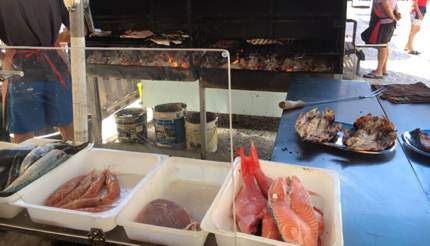
Then dine at the Casa Corvo restaurant where the chef makes a spectacle of grilling fish on the terrace (unlike some local chefs, he doesn’t use the amusing technique of fanning the flames of his grill with a hairdryer). Like many restaurants in the region at this hour, Casa Corvo is already busy at 1pm. Lunching early – in this case off sumptuous dishes of razor clams, langoustine, veal cutlets and sea bream – gives you more chance of getting a table. The bill for this delightful lunch, including wine and water, comes to just under €15 a head.
Escandinavia Green Spirit Recently opened vegetarian restaurant serving a variety of colourful European and Asian dishes, accompanied by local fig salads.
Paiol Local wines can be found at this small tapas bar, where diners perch on wooden stools.
Ria Formosa nature reserve. In the heat of the afternoon, drive along empty roads lined with orange groves, towards the stunning beaches that lie beyond the inlets and estuary of the Ria Formosa nature reserve, a haven for migratory birds. It stretches for more than 60 km, from Faro to the mouth of the Guadiana River, where the peace of Portugal leads to the greater vibrancy of Spain.
At Fuzeta and Tavira you can take boat tours to watch flamingos and dolphins.
Fabrica and Cacela Velha Among the most beautiful, unspoilt spots are Fabrica, and the adjacent fortress remains at Cacela Velha, east of Tavira, where a flight of steps lined with cactus plants leads to an almost deserted, wild beach.
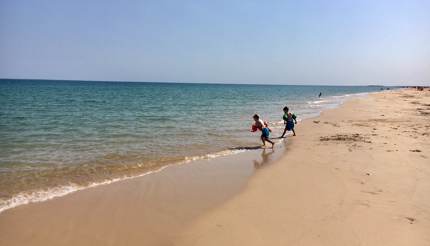
A speedboat ride takes you from the estuary to the beach. There are no bars or sun loungers for rent here, just sand, sun-blasted shells and the odd piece of abandoned rope.
Barril beach At Pedras D’el Rei, 4 kms east of Tavira, Barril beach is reached by taking a mini-train across 1.5km of wetlands, a delight for children and adults alike. The beach is child-friendly, with shaded restaurants and a playground area. An unusual and awe-inspiring sight at Barril is the unique anchor graveyard, which pays homage to the former tuna fishing industry there.
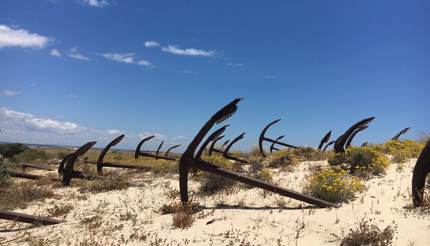
Santa Luzia and Casa do Polvo Tasquinha Just up the road from Pedras D’El Rei is the stunning fishing village of Santa Luzia. It is known as the Eastern Algarve’s octopus capital – check out Casa do Polvo Tasquinha which serves up a wonderful range of octopus dishes.
Seven Recommended Algarve wine producers:
 1 Monte da Casteleja
Elegant and complex organic wines from blends of local grape varieties, using feet maceration, long fermentation and ageing in French oak barrels including the sublime red blend of Bastardo and Alfrocheiro.
montecasteleja.com
1 Monte da Casteleja
Elegant and complex organic wines from blends of local grape varieties, using feet maceration, long fermentation and ageing in French oak barrels including the sublime red blend of Bastardo and Alfrocheiro.
montecasteleja.com
 2 Quinta dos Vales
A key player in the Algarve renaissance with a focus on whites and roses including the fruity but complex, delicious whites from its Grace Vineyard and it top end red Diolog, a blend of petit verdot and cabernet sauvignon.
en.quintadosvales.eu
2 Quinta dos Vales
A key player in the Algarve renaissance with a focus on whites and roses including the fruity but complex, delicious whites from its Grace Vineyard and it top end red Diolog, a blend of petit verdot and cabernet sauvignon.
en.quintadosvales.eu
 3 Quinta do Francês
A leading producer known for its Bordeaux-style reds made from a blend of local and international grape varieties and aged in new oak barrels; check out the silky finesse of the Quinta do Frances Red 2014.
www.quintadofrances.com
3 Quinta do Francês
A leading producer known for its Bordeaux-style reds made from a blend of local and international grape varieties and aged in new oak barrels; check out the silky finesse of the Quinta do Frances Red 2014.
www.quintadofrances.com
 4 Quinta do Barranco Longo
Run by a former orange producer, Quinta do Barranco Longo blends reds from local and international varieties; its range also includes oaked and unoaked rosés and the premium aromatic and unctuous white Remexido wine elaborated from a blend of three white varieties.
www.quintadobarrancolongo.com
4 Quinta do Barranco Longo
Run by a former orange producer, Quinta do Barranco Longo blends reds from local and international varieties; its range also includes oaked and unoaked rosés and the premium aromatic and unctuous white Remexido wine elaborated from a blend of three white varieties.
www.quintadobarrancolongo.com
 5 Cabrita
One of the new Algarve wine generation, Cabrita uses wild yeasts for its reds, rosés, and whites made from blends and single varieties including the Algarve’s indigenous grape variety Negra Mole.
josemanuelcabrita.wixsite.com/
5 Cabrita
One of the new Algarve wine generation, Cabrita uses wild yeasts for its reds, rosés, and whites made from blends and single varieties including the Algarve’s indigenous grape variety Negra Mole.
josemanuelcabrita.wixsite.com/
 6 Monte do Alem
Organic red wines from a blend of Portuguese and international varieties.
www.monte-do- alem.com/en
6 Monte do Alem
Organic red wines from a blend of Portuguese and international varieties.
www.monte-do- alem.com/en
 7 Casa Santos Lima
This Lisbon producer has recently started planting vines into the eastern Algarve where its best wine, aged in French and American barrels, is the Al-Ria Algarve Reserva, a blend of syrah and touriga nacional.
www.casasantoslima.com/en/
7 Casa Santos Lima
This Lisbon producer has recently started planting vines into the eastern Algarve where its best wine, aged in French and American barrels, is the Al-Ria Algarve Reserva, a blend of syrah and touriga nacional.
www.casasantoslima.com/en/
Where to buy Algarve wines:
At local supermarkets, at the wine cellars of Garrafeira Tavira Romana and Garrafeira Soares www.garrafeirasoares.pt in the town of Tavira, and at the Vinhalgarvia wine shop, on Avenida 5 de Outubro, 8700 Olhao
Where to stay:
In Moncarapacho: chic, luxury hotel with lawns and outdoor cinema www.vilamonte.com/en/vilamonte For less expensive hotels try www.taviraterraces.com which rents apartments and rooms in the charming town of Tavira or www.conventoolhao.com which has rooms and suites in the fishing town of Olhao. For a hotel in the countryside, outside Tavira, there is Pensao Agricola, www.pensaoagricola.com/ and www.fazendanova.eu
Activities:
Kitesurfing in Cabanas www.kitesurfeolis.com/en/index.html For olive oil production tours and tastings in Moncarapacho, see www.monterosa-oliveoil.com/en/ Boat for spotting dolphins and bird watching tours: www.passeios-ria-formosa.com/en/


